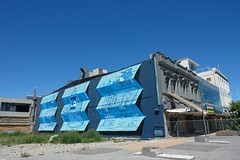
Search
Images for earthquake art; more images...
Poster for Dancing Through Impermanent Spaces
Images, UC QuakeStudies
A copy of the poster used to advertise screenings of Elizabeth Guthrey's film series 'Dancing Through Impermanent Spaces'. The films are a creative response to the earthquakes in Christchurch and were shown as part of the Christchurch Body Festival 2014.
Deb Robertson's Blog 17/08/2014: The "Sure to Rise" quilt
Articles, UC QuakeStudies
An entry from Deb Robertson's blog for 17 August 2014 entitled, "The 'Sure to Rise' quilt".The entry was downloaded on 3 November 2016.
Fairfax Video, January 2014 (2)
Videos, UC QuakeStudies
A video of journalist Charlie Gates introducing the 2014 World Buskers Festival. Gates revisits the performance venues for former festivals to show how the central city has changed since the 2010 and 2011 earthquakes.
Makeshift memory: engaging an aesthetic of transition
Research papers, The University of Auckland Library
To address the provocation provided by the editors I wish to reflect upon the ongoing civic and artistic responses to the earthquakes in Christchurch, New Zealand, 2010-11, in which 185 people lost their lives (largely due to poor engineering and construction practices). Whilst the example is very different in character from that of efforts to memorialize July 22, 2011, I wish to use the case to briefly respond to the issue of temporality as raised by Jacques Rancière in his critique of the ‘endless work of mourning’ produced by testimonial art. The orientation of this mourning, he argues, is always backward-looking, characterized by, ‘a reversal of the flow of time: the time turned towards an end to be accomplished – progress, emancipation or the Other – is replaced by that turned towards the catastrophe behind us.’ How might memorial practices divide their gaze between remembered pasts and possible futures? AM - Accepted Manuscript
Assessment of seismic behavior of full-scale instrumented buildings using …
Research papers, The University of Auckland Library
The full scale, in-situ investigations of instrumented buildings present an excellent opportunity to observe their dynamic response in as-built environment, which includes all the real physical properties of a structure under study and its surroundings. The recorded responses can be used for better understanding of behavior of structures by extracting their dynamic characteristics. It is significantly valuable to examine the behavior of buildings under different excitation scenarios. The trends in dynamic characteristics, such as modal frequencies and damping ratios, thus developed can provide quantitative data for the variations in the behavior of buildings. Moreover, such studies provide invaluable information for the development and calibration of realistic models for the prediction of seismic response of structures in model updating and structural health monitoring studies. This thesis comprises two parts. The first part presents an evaluation of seismic responses of two instrumented three storey RC buildings under a selection of 50 earthquakes and behavioral changes after Ms=7.1 Darfield (2010) and Ms=6.3 Christchurch (2011) earthquakes for an instrumented eight story RC building. The dynamic characteristics of the instrumented buildings were identified using state-of-the-art N4SID system identification technique. Seismic response trends were developed for the three storey instrumented buildings in light of the identified frequencies and the peak response accelerations (PRA). Frequencies were observed to decrease with excitation level while no trends are discernible for the damping ratios. Soil-structure interaction (SSI) effects were also determined to ascertain their contribution in the seismic response. For the eight storey building, it was found through system identification that strong nonlinearities in the structural response occurred and manifested themselves in all identified natural frequencies of the building that exhibited a marked decrease during the strong motion duration compared to the pre-Darfield earthquakes. Evidence of foundation rocking was also found that led to a slight decrease in the identified modal frequencies. Permanent stiffness loss was also observed after the strong motion events. The second part constitutes developing and calibrating finite element model (FEM) of the instrumented three storey RC building with a shear core. A three dimensional FEM of the building is developed in stages to analyze the effect of structural, non-structural components (NSCs) and SSI on the building dynamics. Further to accurately replicate the response of the building following the response trends developed in the first part of the thesis, sensitivity based model updating technique was applied. The FEMs were calibrated by tuning the updating parameters which are stiffnesses of concrete, NSCs and soil. The updating parameters were found to generally follow decreasing trends with the excitation level. Finally, the updated FEM was used in time history analyses to assess the building seismic performance at the serviceability limit state shaking. Overall, this research will contribute towards better understanding and prediction of the behavior of structures subjected to ground motion.



